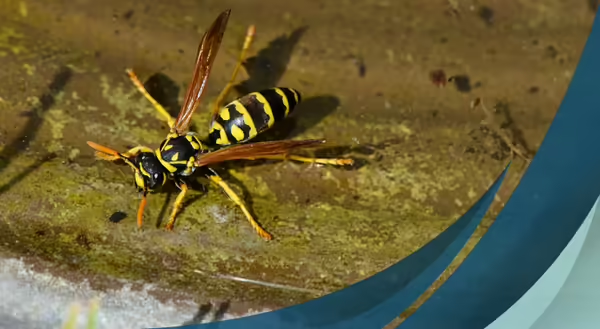
It’s that time of year again. In the fall, yellowjacket wasps (often mistaken for bees) have reached peak populations, becoming more noticeable as they hunt for food—often in garbage cans, hummingbird feeders, or your can of pop. Why are they suddenly so aggressive and what can you do about it?
What is a yellowjacket?
Yellowjackets (Vespula vulgaris) are a small wasp, often mistaken for honeybees due to their similar shape. Unlike the muted orangey-yellow and black striping of honeybees, however, yellowjackets are bright yellow and black and lack the fuzzy appearance of bees. Both insects live in social colonies with a single queen, but while honeybees prefer above-ground spaces like cracks and crevasses in trees, yellowjackets live in nests underground.
Yellowjackets in fall
Yellowjackets spend all spring and summer doing double duty as both pollinator and pest control. They can often be found buzzing around my yard on the swamp milkweed or the mountain mint, drinking nectar, and swarming the apple tree for rotting fruit. However, they’re not just vegetarians—they will eat spiders, crickets, slugs, and other insects, as well. By the time the first hints of fall begin to replace summer’s warm breezes, the colony is reaching maximum size. All those hungry mouths are looking for food that is becoming more and more scarce. (I know when I’m hungry and bored, I also get cranky!) While you enjoy your outdoor dining, they also will help themselves to your plate of goodies or your sweet beverage, becoming aggressive when swatted away. In fact, if frightened, they will emit a chemical calling in reinforcements. Often, if they’re left alone, they’ll investigate and then move on. If they’re bothering you, your best bet is to cover or get away from any food they might be attracted to and gently move them along with a piece of paper or something similar. Stay calm and avoid swatting at them or flailing your hands, as this can agitate them.
What to do about them?
If you find a nest in your yard, it’s best to leave it alone, as long as it’s not somewhere people or pets frequent. After 5 to 7 days of temperatures below 45°F, the workers will die (the queens overwinter underground). They will not reuse nests.
If it’s near an area where people or pets would be at risk of stings, you might consider treating it. If you’re uncomfortable doing it yourself, hire a professional. Otherwise, if it’s a ground nest, insecticide dust containing either permethrin or carbaryl can be placed in and around the nest, or the exit hole can be drenched with an approved pesticide. Cover the hole with a shovelful of dirt or a container to block it afterward. Any treatment should be done at night when it’s cool, and the colony is less active. If possible, don’t use a flashlight, but if needed, cover the light with red cellophane. Wear protective clothing such as long-sleeved shirts and pants, tying pantlegs shut or covering them with socks. (And always read and follow label instructions!)
Even if there isn’t a nest nearby, you may still be visited by foragers. Traps can be used to draw them away from areas frequented by people. Keep lids tightly on outdoor trashcans and use bee guards on hummingbird feeders to discourage visitors.
For more information on yellowjackets or other pests, visit extension.illinois.edu/insects.